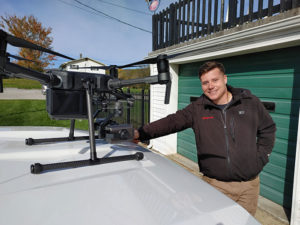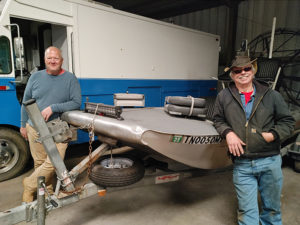By Scott Barkley and Lonnie Wilkey
Baptist Press, B&R

Brandon Ramsey displays his drone which he has used in rescue situations in Tennessee. He is a member of Pleasant Hill Baptist Church, Rogersville. — Photos by Lonnie Wilkey
MORRISTOWN — When a teenage girl went missing in the East Tennessee mountains while walking her dogs, emergency responder Brandon Ramsey was able to do in 10 minutes what searchers on the ground couldn’t in more than two hours.
Ramsey was pouring concrete on a construction job when he and other volunteer members of Bean Station Fire and Rescue got the call.
Fascinated with drones since he was a boy, the 18-year-old is aware of the advantage that accompanies a view from above. On that day, the thermal camera on his DJI Matrice 219 V2 quickly located the teenager who had wandered about a half-mile from the trail.
Ramsey, a member of Pleasant Hill Baptist Church in Rogersville, also serves as the primary drone pilot for Nolachucky Baptist Association Disaster Relief. That role, said Southern Baptist Disaster Relief national director Sam Porter, is the first of its kind. With the advantages it brings, though, he hopes that doesn’t remain the case for long.
“It is a tremendous help to be able to fly up and hover over disaster sites to see all sides of any kind of debris,” he said. “This allows the teams to know how to strategize how best to assist the homeowners and to help the teams know what equipment is needed to respond.”
Thus far, the drone has been used to help locate those missing or deceased after natural disasters such as tornadoes, floods and hurricanes. It was instrumental in locating the source of flooding in Waverly as Ramsey guided it to a remote railroad bridge where debris had collected and effectively created a dam.
Its most immediate benefit, though, is giving responders an idea of what they’re about to encounter.
“We’ve used it as an assessor,” Ramsey said. “It lets us see what kind of damage there is and helps us get a picture of where we’re to begin.”
Porter agreed. “It actually is also a safety issue letting volunteers assess the entire area without having to walk through dangerous debris,” he said.
The association also is developing a swift-water rescue team that will work in tandem with the drone. That decision, said DOM David Hawkins, came after observing the need for such a response following hurricanes or flooding.
Perhaps the busiest part of the association’s recent disaster relief work has come from debris removal. After retiring, DR leader Dale Moles retained several trucks and other equipment from his company that he now uses in disaster relief. The equipment was first used eight years ago to clear out homes charred by forest fires in Colorado, and the Nolachucky Association was called to do the same thing in 2016 after devastating fires in Gatlinburg. Most recently, they hauled away debris and wreckage from tornadoes in northwest Tennessee.

Dale Moles, right, and Terry Wolfe stand beside Moles’ airboat which they have used for water rescue efforts for disaster relief.
Moles, who is Ramsey’s grandfather, also oversees the drone and swift-water rescue efforts. Both are instrument-rated aircraft pilots with Ramsey soon to be a commercial-rated pilot.
Moles is the association’s backup drone pilot. Both he and his grandson are fully licensed for unmanned aircraft systems (UAS) operations.
Moles actually began his boat rescue ministry before he had a boat. When a hurricane hit Texas about five years ago, he and a friend heard that boats were needed for rescue ministry so they headed immediately to Texas. On the way, they stopped and Moles bought a 22-foot airboat. They spent a week helping with 42 water rescues in Port Arthur, Texas, he said.
After that, Moles and another friend, Terry Wolfe, “began chasing hurricanes,” heading to locations where hurricanes were predicted to hit. “When a hurricane stalls, that is when water rescue boats are needed,” Moles explained.
They originally worked through an organization known for its water rescue efforts but was not completely satisfied, Moles recalled. “We started looking for a way to go out on our own, but they needed certification,” he related.
Moles, a member of Lakeshore Baptist Church, Bean Station, was involved with disaster relief work with Nolachucky Baptist Association and talked with Don Owen, DR leader, and director of missions David Hawkins about adding water rescue to the association’s DR ministry.
Later, they held meetings with Porter of the North American Mission Board and Wes Jones, disaster relief specialist for the Tennessee Baptist Mission Board. The water rescue and drone ministry became a part of Tennessee Baptist Disaster Relief and Nolachucky Baptist Association.
“Disaster relief has opened up doors for a lot of opportunities,” Moles said.
In addition, the disaster relief banner allows them to share Christ through their words and actions, the two men said.
In addition to helping with rescue efforts, the men also assess needs for disaster relief teams, added Wolfe, a member of Barnards Chapel Missionary Baptist Church in Bean Station. “We try to find out what is needed for teams to better respond,” he said.
Wolfe noted that water rescue can be dangerous. “You occasionally put yourself in harm’s way,” he acknowledged. “You focus on the mission and the task, not what could happen to you,” he added.
“There’s no other feeling like it when you rescue someone,” Wolfe continued.
Moles concurred, noting that every rescue is different. “It’s something that you have to want to do,” he stressed. Wolfe agreed. “It’s a calling.” B&R — Barkley writes for Baptist Press; Wilkey is editor of the Baptist and Reflector.
